I blame the three Italians. Felice Benuzzi’s brilliant book, No Picnic on Mount Kenya, is based on his World War II escape, with two fellow Italian prisoners of war, from a British prison camp, their ascent of Mt Kenya’s Point Lenana and return to prison camp. If I hadn’t read it, I wouldn’t be here now. Here being 4.30am, freezing cold, in the dark, at about 4700m – above most of Africa – and still an hour from Point Lenana’s summit. It sounds miserable but is far from it: just like Benuzzi’s tale, this trek, via the spectacular Chogoria route, has proved fantastic.
Seconds up
At 5199m, Mt Kenya is Africa’s second-highest mountain and, unusually, is comprised of many separate peaks, rather than a single summit. This is the result of the erosion of Mt Kenya’s original ice cap during two glacial periods. For scientists, its past is of great interest; for today’s adventurers, it represents a goldmine of opportunity. Trekkers can tackle Point Lenana via eight different routes, but the Chogoria, says our guide Eddie, allows for the best chance of acclimatisation and summit success. Climbers can attempt any number of the other peaks – the true summit of Batian (5199m) is their main goal. The various peaks comprise a plethora of vertical tests, from day scrambles to ice climbing.

For our group – a mix of Australians, Kiwis, two Canadians and a Californian – the trekkers’ peak of Point Lenana is the goal. This Mt Kenya climb promises varying scenery and excitement, which we get from the very start. From the village of Chogoria to the trek’s start-point, we are treated to one of the wildest four-wheel drive journeys I have ever undertaken (in my past life, I was a 4WD magazine editor). The two Land Rovers we’re in are pushing 50 years of age, smell like they may still be running their original clutches and – as we bounce up as much as move forward – I can confirm are still on their original suspension. When we’re not bouncing up and down, we are leaning precariously to one side or the other as the Landies scrabble their way up a muddy, deeply rutted track surrounded by dense forest while the (admirably skilled) drivers swap gears furiously to maintain forward momentum. It’s an absolute hoot and when we climb out my large exhalation of breath is more because of a slight sadness that the mini adventure is finished than relief at being in one piece. Well, mostly…
A whole new world
There’s always a settling-in period on a multi-day trek – the first day is usually pretty cruisey and you have the chance to get to know your fellow trekkers and tent mates (I am shacked up with a fellow Aussie, Marcus, in a generous three-man tent) before the invariable grunt-fest starts in the following days. Mt Kenya proves no different – we follow a vehicle track up most of today, through a mix of forest and open fields. We are on our way to what will be our first – and only – taste of semi-luxurious digs: cottages just inside the Chogoria gate entrance to Mt Kenya National Park. The cottage site has great views of the distant summits and also provides some entertainment early the next morning when we watch a couple of monkeys search for – and steal – some food.
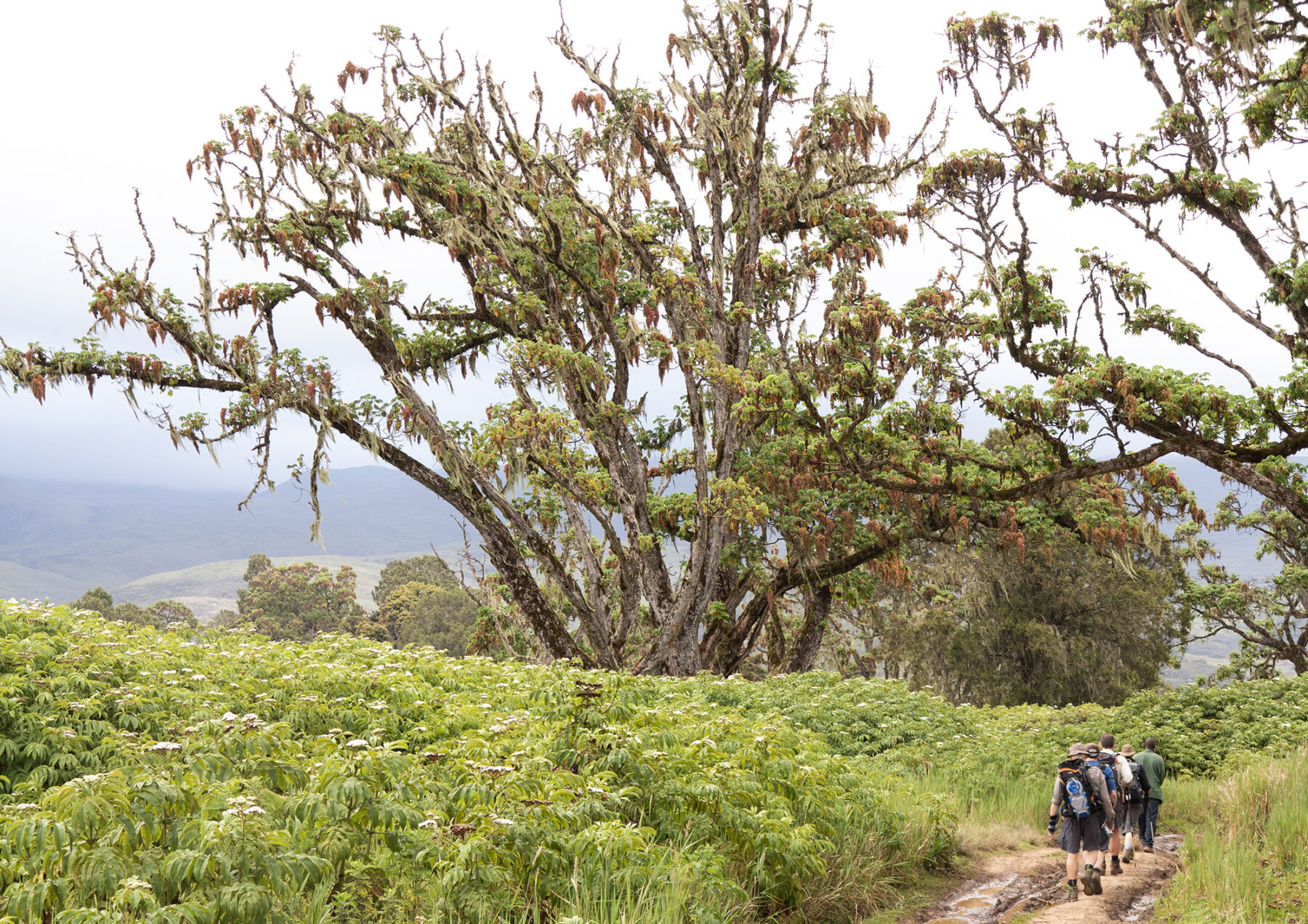
One of this trek’s big attractions is the varying terrain and this morning provides our first taste of it as Eddie leads us through forest, then higher and out into the vast, open grasslands en route to our next camp at Lake Ellis. The track is quite wide – and it is bloody hot – but the walking is great, and we soon forget the heat. It is also along this section that we first witness our porters’ impressive qualities: large dining tables, massive kitchen/dining tents, chairs and a couple of eskies are just some of the gear the porters carry using basic rope-harness systems – all at a pace appreciably faster than us with our daypacks.
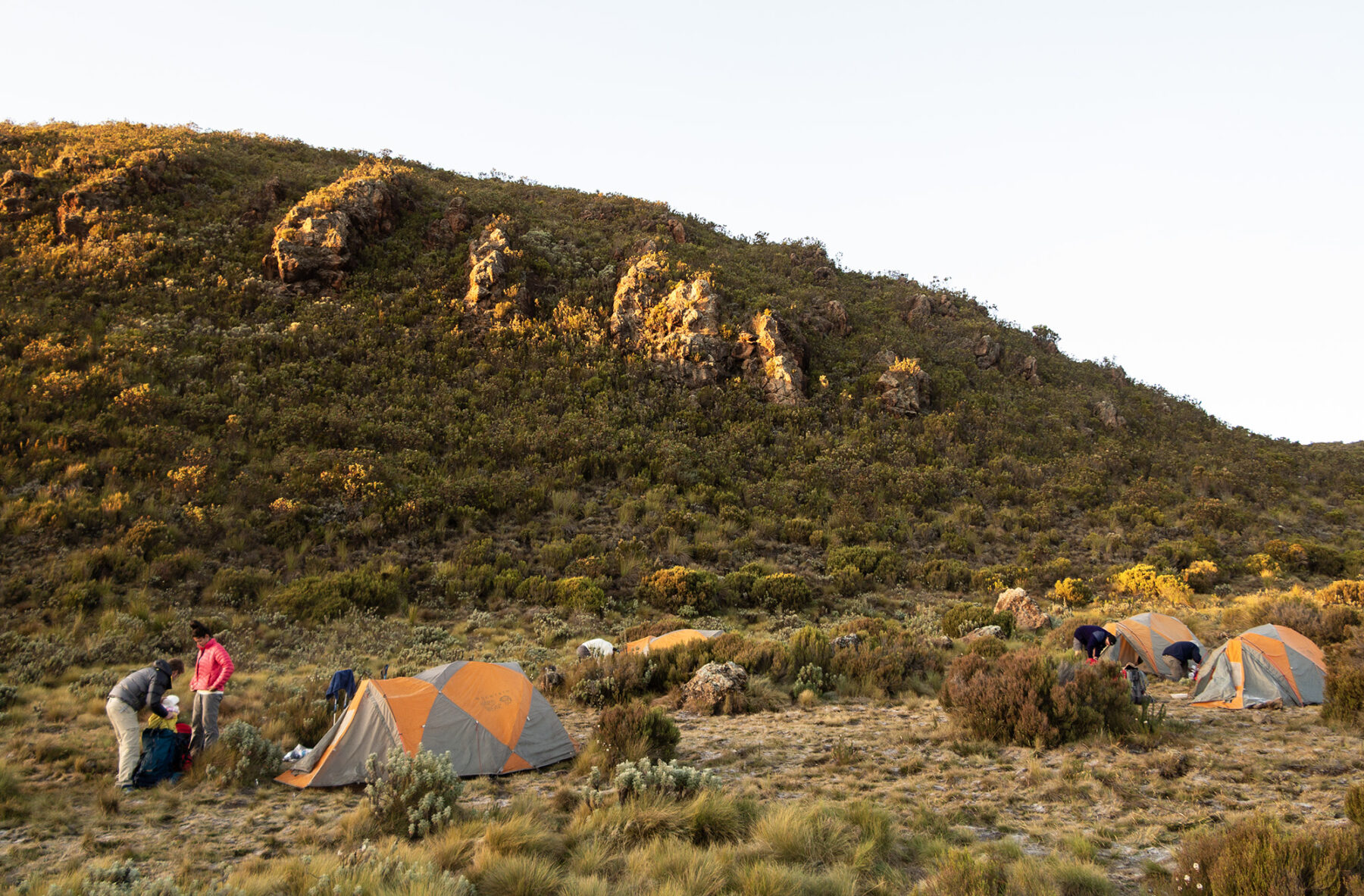
The gradually increasing altitude slows us up somewhat but Eddie has our acclimatisation well controlled – we are ascending about 500m each day – with quick jaunts fractionally higher before dropping down to our camp sites. Today, we undertake a quick ascent of Mugi Hill (at 3600m) for lunch, before descending 100m to Lake Ellis. Atop Mugi Hill we first appreciate the national park’s vastness, and that of Mt Kenya itself. Peaks surround us, including the main three that are our ultimate goal. From our high vantage point, we watch as a large herd of zebra cruises around below, oblivious to us. The vastness of the landscape and its four-legged inhabitants’ ignorance of us are a great reality check, reminding us of our small place in this huge world.
During the final hour to Lake Ellis we leave the main track and follow a narrow track through grasslands, crossing small creeks along the way. (The valleys below the high peaks are full of creeks and rivers, created by the glacial- and snowmelt, providing the farms far below with regular irrigation.)
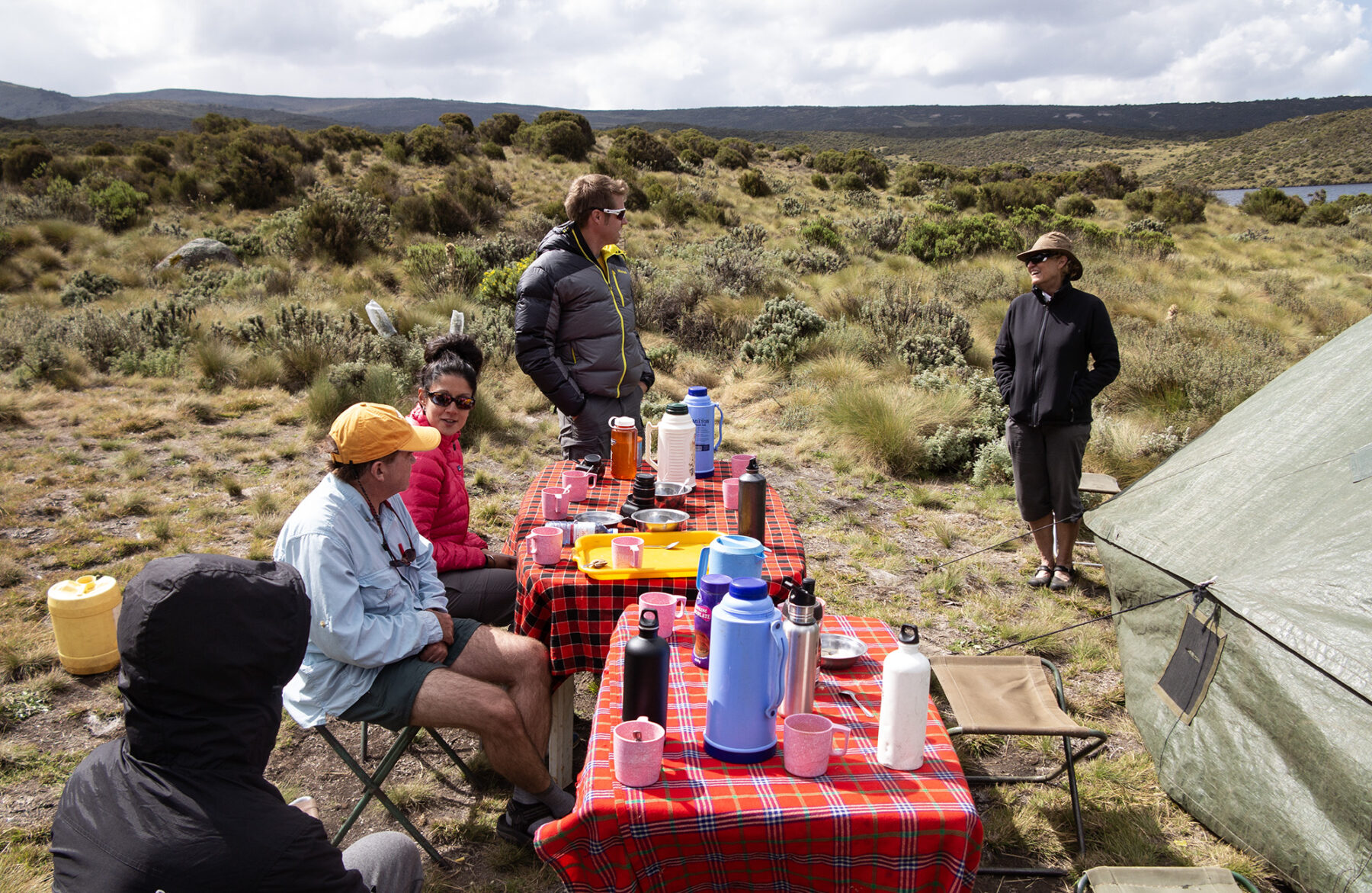
Lake Ellis is impressive – as is our already set-up camp site. The porters are kicking back as if they’ve been here for hours and we’re lucky enough to have it all to ourselves. Over-indulged? Maybe, but we make the most of it, gathering around our dinner table for pre-dinner aperitifs and taking the chance to put our feet up and rehydrate before a massive dinner and a quick yarn with Eddie about the next day’s trekking.
A gorge-ous surprise
We strike high moorlands the following morning, continuing our steady climb –and continuing to be accompanied by the sun. We’re on our way to a high ridge that joins the main Chogoria route, and the terrain is getting progressively rugged – rocky escarpments are visible on the horizon – and the vegetation is also changing, with giant rosetta plants (Dendrosenecio keniodendron) now prevalent among the flowering lobelias. The size and shape of these rosetta plants, when seen silhouetted against the craggy mountains, suit the landscape’s prehistoric appearance. We are now in the mighty Gorges Valley.

Our biggest surprise comes when we top out on a ridge (at about 4000m) close to our camp at Lake Michaelson. The craggy spires above dwarf us, but even more amazing is the massive view below and all around us in the Gorges Valley – it seems to go on forever and is spectacular, with Vivienne Falls in the distance and our camp site below. The camp site is beautiful, nestled against the bottom of the immense cliffs we’re about to descend, with the expanse of Lake Michaelson beside it. As we descend a narrow, muddy track to the camp, I’m distracted by the sublime scene below and struggle to concentrate on where my feet are going. The lake is big, but dwarfed by the rock amphitheatre that surrounds all but its far shore. I have camped in some epic locations, but this one ranks very high, even more so when we realise it is all ours. We share this unique location only with birds and hyrax – small, furry (and fat) mammals that look like a large rat but are, amazingly, more closely related to elephants.
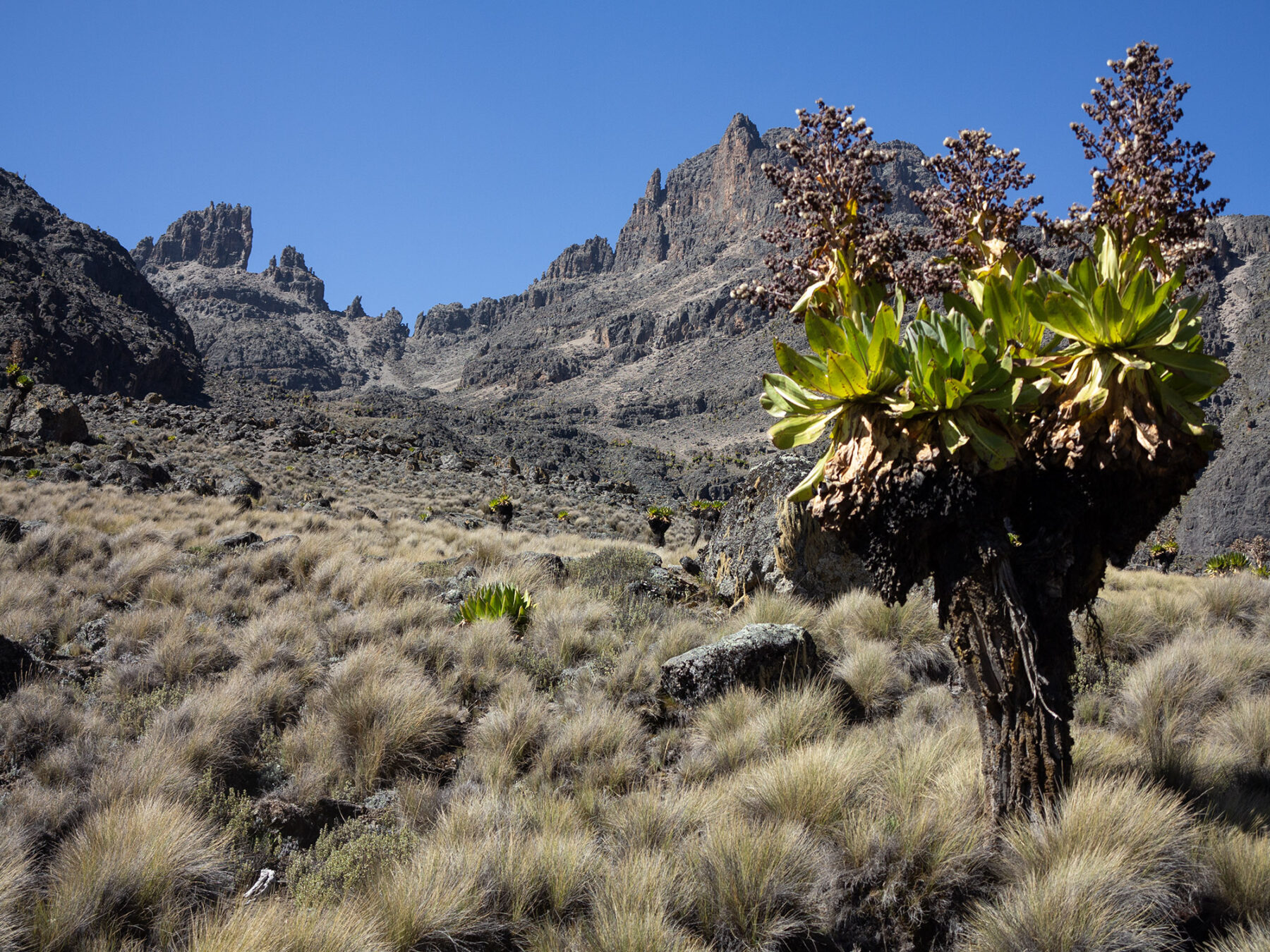
The mood at camp is tinged with nervous energy – we are only one more camp away from our summit attempt on Point Lenana – as well as amazement at this beautifully unexpected change in terrain. Looking back at our first day, and the trail up to the cottages through rolling forest and hills, this massive cliff-surrounded location really does seem a world away. A small track winding back up the cliffs behind us is a teaser for the big ascent ahead but, thankfully, none of us have – so far – copped any altitude sickness symptoms, thanks to Eddie’s steady pacesetting up front. It would be easy to race off but none of us wants to jeopardise our chances of standing atop Lenana in two days’ time.
All time high
The scramble past rushing waterfalls to the ridge above Lake Michaelson is a great reminder of just how high up we are. Even only slightly rushing steps reward me with a shortage of breath. Breath that is further taken away when we reach the top of this muddy track and witness the grandeur of the path ahead. With the many surrounding peaks (each one a climber’s dream with their spire-like appearance) and more barren terrain underfoot, we have truly entered the alpine zone. I am trying to get a glimpse of the ever-shrinking glaciers still found on Mt Kenya when I nearly trip over leopard scat – full of hyrax fur – smack-bang in the middle of the track. Suddenly those rocks and caves above us take on a more menacing appearance…
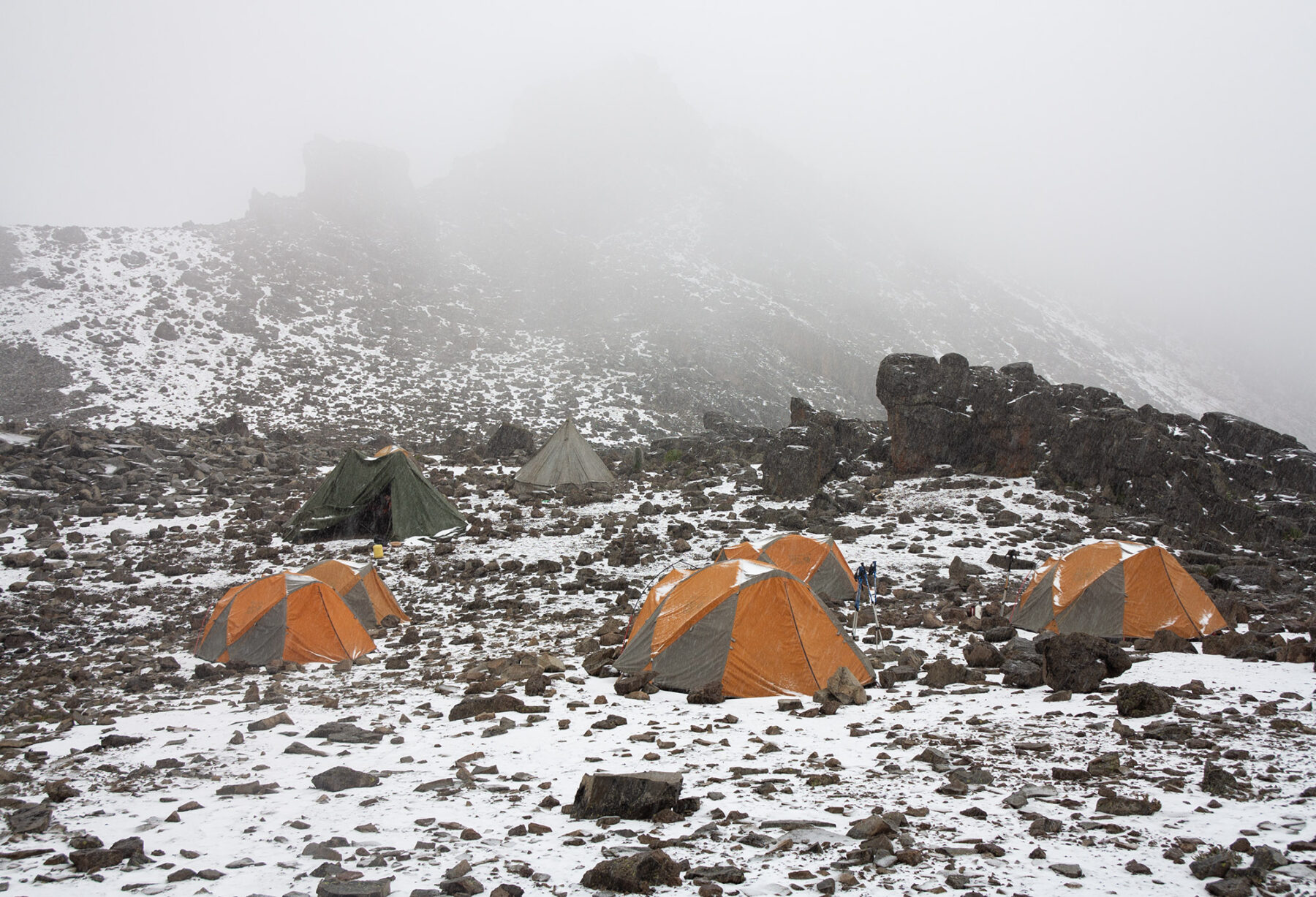
In alpine terrain, things often look a hell of a lot closer than they are and this definitely proves the case as we start the slog up to Simba Tarn, our high camp; only the teasing – but fast disappearing – views of the porter-borne esky and dinner table offer any indication of just how much further we have. Taking the last step over the edge and onto the flat basin of Simba Tarn camp site is a relief, accompanied by a sense of achievement as I look back down the valley. Lakes, knife-edge ridges and jagged peaks are below us, with only a small cliff surrounding our camp site – and some large boulders on the far side – hinting at what is above.
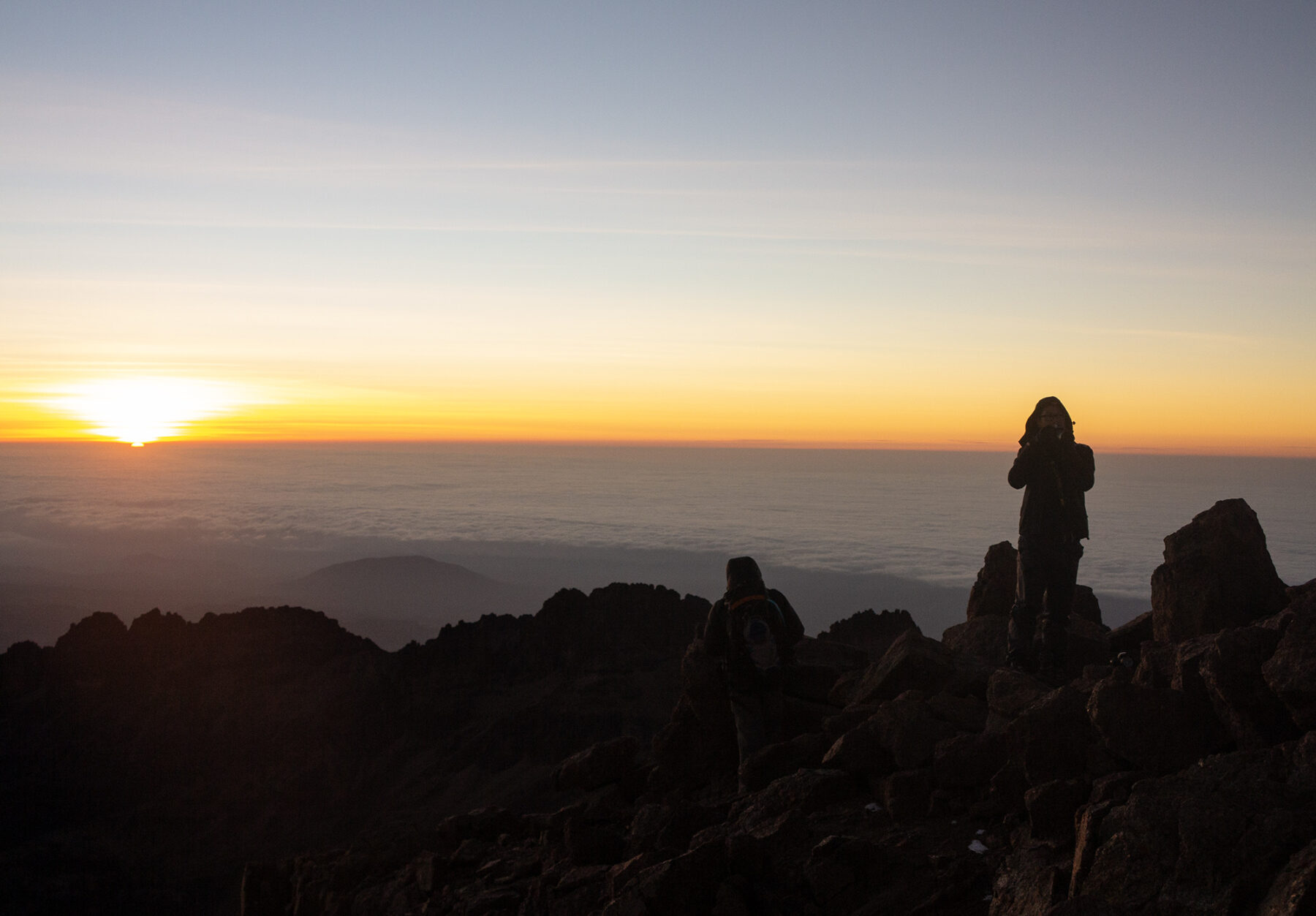
The weather so far has been fantastic, with loads of sun each day and zero precipitation. This is all turned on its head within a couple of hours of our arrival, however, when a hail and sleet storm batters camp. It is hard to believe my eyes as the clouds gather quickly above us, then the storm punches down. The bare, rocky camp is soon covered in a white blanket and the temperature drops sharply, causing a mad scramble for extra layers. It doesn’t bode well for our 4am start to the summit the next morning, but Eddie is unfazed, promising a clear day with a sunrise summit.
Alpine starts are never fun: getting up way too early, fumbling around under head-torchlight getting dressed, unpacking and repacking the backpack you know you loaded properly the night before, and actually taking that first cold step outside your warm tent. As with many uncomfortable endeavours, though, the result is worth the discomfort, and the trek up to Point Lenana proves this theory yet again. It takes us about two hours, and we arrive just in time for the pre-dawn light to help us find our way for the final scramble to the top. To say the view is spectacular is a serious understatement: the impressive Batian stands what seems like only an arms-length away, with the rising sun slowly lighting it up, forcing your mind to trace imaginary climbing routes up its flanks. Across the flat African landscape below, Mt Kilimanjaro’s distinctive curved shape can be seen on the far horizon, more than 300km away. And the Gorges Valley’s myriad spires, lakes and mountains fan out below us. The 360-degree view is immeasurable in its majesty – I snap what seems like a hundred photos but know that no image will do the vista justice.
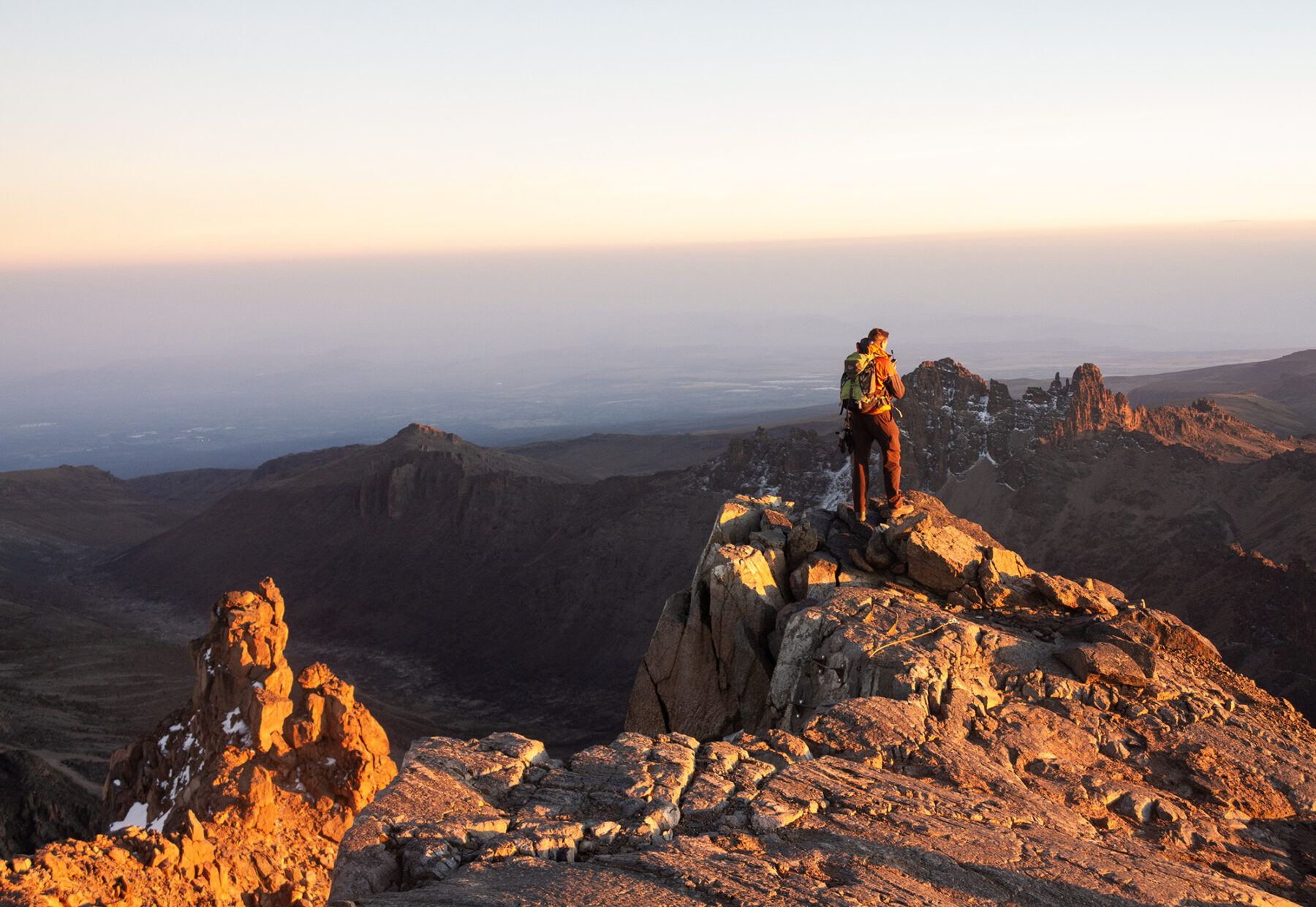
The return
The descent is fast. The sun soon bathes the mountain in bright light, and we take this as our cue to head back down to high camp, at last able to see properly the track we ascended hours before in the dark. Breakfast awaits, and after it has been bolted down a hurried pack-up of all our gear ensues before the long walk begins. The trek down is steep and slippery – due to the mix of loose dirt and muddy, half-melted snow and hail – but I still allow myself time to pause and turn around to look back at Lenana and Batian towering above us.
We pause briefly at Shipton’s Camp (named after Eric Shipton, a British mountaineer and explorer who climbed Nelion and Batian in the 1930s). At 4200m, this is often the last night before summit attempts for those using the Sirimon route. Guides are lugging rock-climbing gear at this camp, indicating a possible attempt at Batian is underway. It would be a grand feat – and a difficult one considering the challenge of rock climbing for more than 20 pitches up the mountain in the thin air. Still, I tag it mentally as another potential for the bucket list – the peak’s beautiful lines beg to be climbed and, as we noticed up on Lenana, there’s even the option of an overnight stay in Batian’s tiny climbers’ shelter as an added attraction. That will have to wait for another day, however, as all our efforts are focused on continuing the (mostly) downhill trek to Old Moses Camp, which, at 3000m, represents a near-2000m drop from our heady morning at the top of Point Lenana.
By the time we reach Old Moses Camp, we’re fairly spent. It’s been a massive day, with the early morning highlight followed by hours of trekking down through still more amazing terrain.
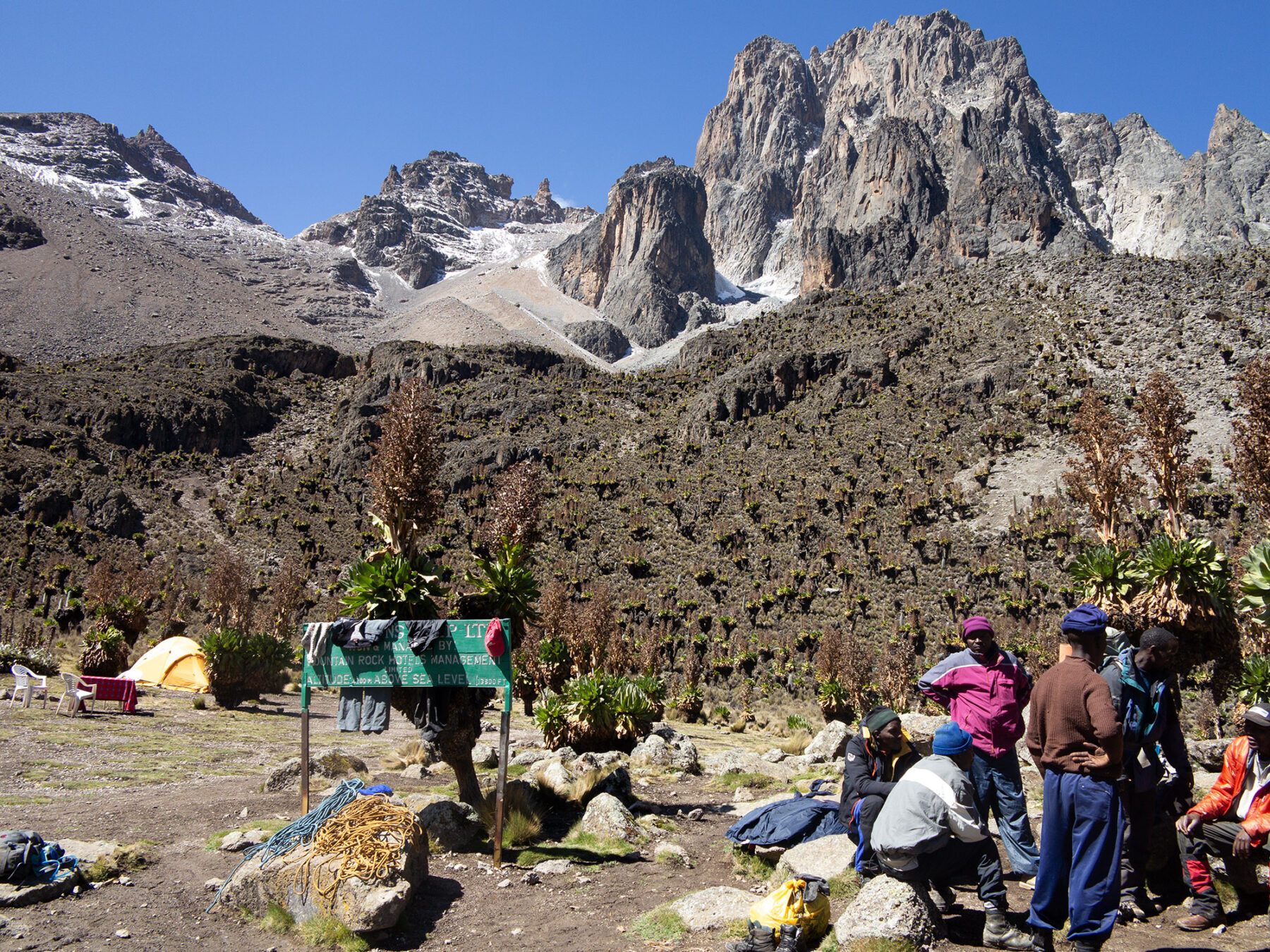
The last day of any adventure is bittersweet and the final walk down the Sirimon Valley to the Mt Kenya NP gates is no exception. We spot baboons and monkeys, as well as copious amounts of elephant dung but miss out on seeing any of these giant forest dwellers. Instead, we have to be satisfied with the huge piles of manure and telltale slide marks down forest banks where the elephants have crossed the road. We also pause briefly on the equator, taking the chance to, figuratively, straddle the world, before the final hour leads us to the park entrance.
Sitting outside the national park office, with Mt Kenya just visible on the far horizon, I can now appreciate the “why” behind Benuzzi’s crazy escape and climb. Mt Kenya encapsulates what adventure is all about: taking you through the heart of a wild country and topping it all off with a magnificent mountain summit. Even Benuzzi’s captors understood – the British POW camp commander the trio returned to reduced their punishment to seven days of solitary confinement (rather than 28) and lauded their escape and climb as a “sporting effort”. I have to agree: if there’s anything that makes you lose any vestige of common sense and head out chasing adventure, it is the trek up Mt Kenya.
The Essentials
The adventure: The World Expeditions Mt Kenya Ascent trip is seven days and is via the Chogoria and Sirimon routes, respectively. You need to be fit and an experienced trekker.
Getting there: You will need a visa for Kenya. Kenya Airways does a codeshare arrangement with Thai Airways, so you can book your luggage all the way through to Nairobi from your start point. The flight is long but the service from both airlines is fantastic.
More info: For Kenya Airways’ flights to Nairobi – check www.kenya-airways.com. For travel to Kenya, check www.magicalkenya.com.
